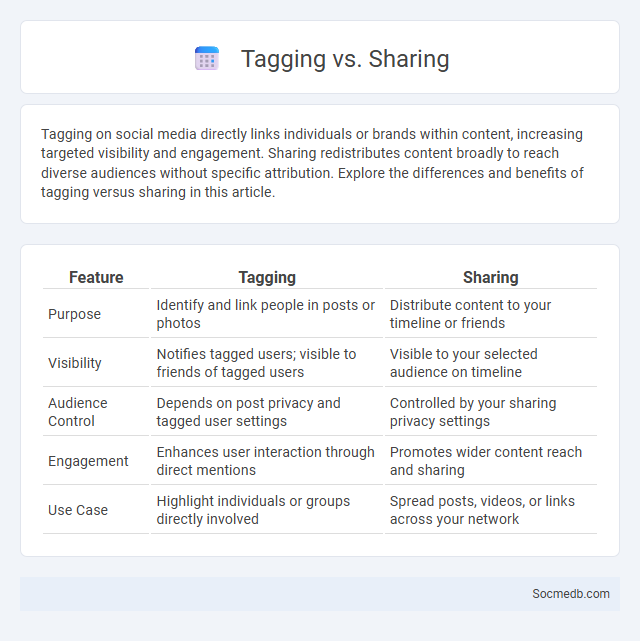
Photo illustration: Tagging vs Sharing
Tagging on social media directly links individuals or brands within content, increasing targeted visibility and engagement. Sharing redistributes content broadly to reach diverse audiences without specific attribution. Explore the differences and benefits of tagging versus sharing in this article.
Table of Comparison
| Feature | Tagging | Sharing |
|---|---|---|
| Purpose | Identify and link people in posts or photos | Distribute content to your timeline or friends |
| Visibility | Notifies tagged users; visible to friends of tagged users | Visible to your selected audience on timeline |
| Audience Control | Depends on post privacy and tagged user settings | Controlled by your sharing privacy settings |
| Engagement | Enhances user interaction through direct mentions | Promotes wider content reach and sharing |
| Use Case | Highlight individuals or groups directly involved | Spread posts, videos, or links across your network |
Understanding Tagging: Definition and Purpose
Tagging in social media involves labeling people, places, or topics within posts to enhance content visibility and user engagement. This feature allows Your connections to easily identify and interact with relevant content, fostering a sense of community and increasing reach. Effective tagging boosts discoverability through targeted keywords and improves the organization of shared information across platforms.
What is Sharing? Key Concepts Explained
Sharing on social media involves distributing content such as text, images, videos, or links across platforms to engage audiences and increase visibility. Key concepts include virality, where shared content rapidly spreads; user engagement, which measures likes, comments, and shares; and privacy settings that control who can view or interact with the shared material. Effective sharing boosts brand awareness, fosters community interaction, and drives traffic to original sources.
Tagging vs Sharing: Core Differences
Tagging on social media links specific people directly in posts or photos, enhancing visibility and engagement by notifying those tagged. Sharing involves redistributing content to your own network, broadening the reach beyond the original audience without directly notifying individuals. Understanding these core differences empowers you to strategically increase interaction and content exposure across platforms.
Benefits of Tagging in Digital Content
Tagging in digital content boosts your social media visibility by connecting posts to relevant topics, trends, and communities, increasing engagement and reach. It enhances content discoverability, making it easier for your target audience to find and interact with your posts. This strategic use of tags fosters stronger brand awareness and drives higher traffic to your profile or website.
Advantages of Sharing Across Platforms
Sharing content across multiple social media platforms amplifies your reach by tapping into diverse audiences and increasing visibility. This strategy enhances engagement rates, as tailored posts resonate with platform-specific users, driving higher interaction and brand awareness. Leveraging cross-platform sharing empowers your marketing efforts through consistent messaging and efficient content distribution.
When to Tag vs When to Share
Tagging on social media is ideal when you want to directly involve specific individuals or brands in a conversation, increasing visibility and engagement within their networks. Sharing content is best used to amplify messages broadly without necessarily involving the original creators directly, thereby reaching a wider audience. Effective use of tagging versus sharing enhances social media strategy by targeting interactions and maximizing content distribution.
Common Mistakes in Tagging and Sharing
Incorrect tagging on social media often leads to miscommunication and reduced post visibility, as irrelevant or excessive tags can confuse algorithms and your audience. Sharing private or sensitive content without proper permission risks your reputation and infringes on privacy rights. You should always double-check tags for accuracy and be mindful of what you share to maximize engagement and maintain trust.
Impact of Tagging and Sharing on Engagement
Tagging users in social media posts significantly increases visibility by directly notifying involved individuals, thereby boosting engagement through comments and shares. Sharing content extends reach beyond immediate followers, amplifying audience interactions and fostering community growth. Both tagging and sharing strategies enhance algorithmic favorability, leading to higher organic content exposure and sustained user engagement.
Best Practices for Effective Tagging and Sharing
Effective tagging and sharing on social media amplify your content's visibility by targeting relevant audiences and increasing engagement. Utilize precise and popular hashtags related to your niche or industry to maximize reach while ensuring tags accurately represent your content to avoid misleading users. Encourage your audience to share and interact with your posts by creating compelling, share-worthy content that aligns with current trends and platform algorithms.
Future Trends: Evolution of Tagging and Sharing
The future of social media is set to transform tagging and sharing through advancements in artificial intelligence and augmented reality, enabling more personalized and context-aware content interactions. Predictive tagging will allow platforms to automatically identify and categorize people, objects, and locations with higher accuracy, enhancing user engagement and content discoverability. Emerging trends also include immersive sharing formats like 3D posts and virtual spaces that redefine digital communication and community building.
 socmedb.com
socmedb.com